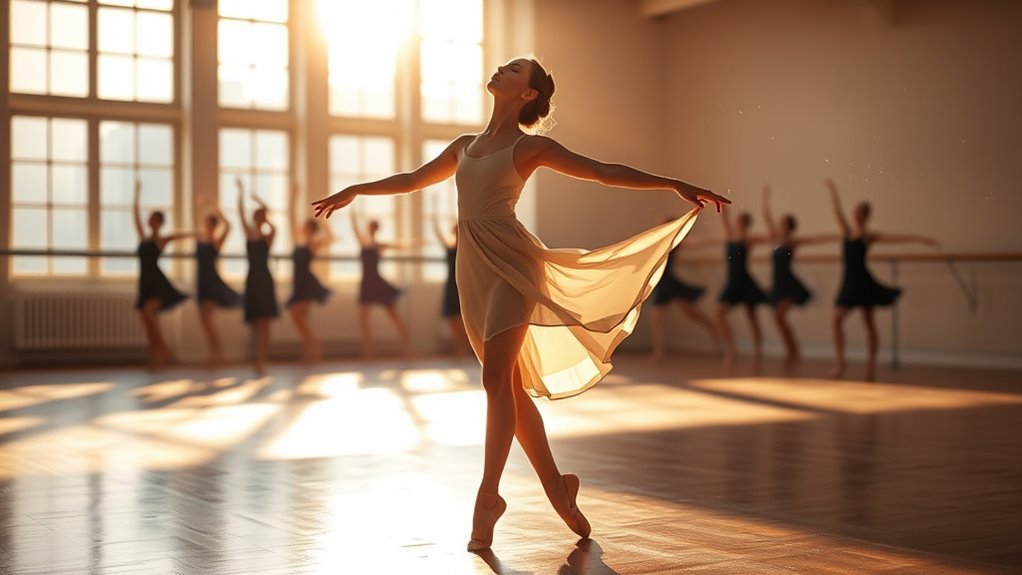Mindfulness is key for dancers to enhance physical awareness and mental capabilities. By tuning into your body, you’ll recognize limits and prevent injuries. Regular mindfulness practices sharpen focus, ease performance anxiety, and foster emotional resilience. You’ll find that being present boosts your creativity and improvisation skills. Engaging in somatic practices further cultivates this mind-body connection, promoting holistic wellness. There’s so much more to explore that can elevate your dance journey and expression.
Key Takeaways
- Mindfulness enhances physical awareness, allowing dancers to tune into their bodies and recognize limits to prevent injuries.
- Regular practice of mindfulness improves focus and concentration, helping dancers achieve a flow state during performances.
- Breathing exercises reduce stress and sharpen mental clarity, essential for handling intense dance sessions.
- Mindfulness encourages creative spontaneity and emotional connection, enriching improvisational skills and expression in dance.
- Techniques like body scans and somatic practices foster a holistic mind-body connection, enhancing performance and promoting relaxation.
Enhancing Physical Awareness Through Mindfulness
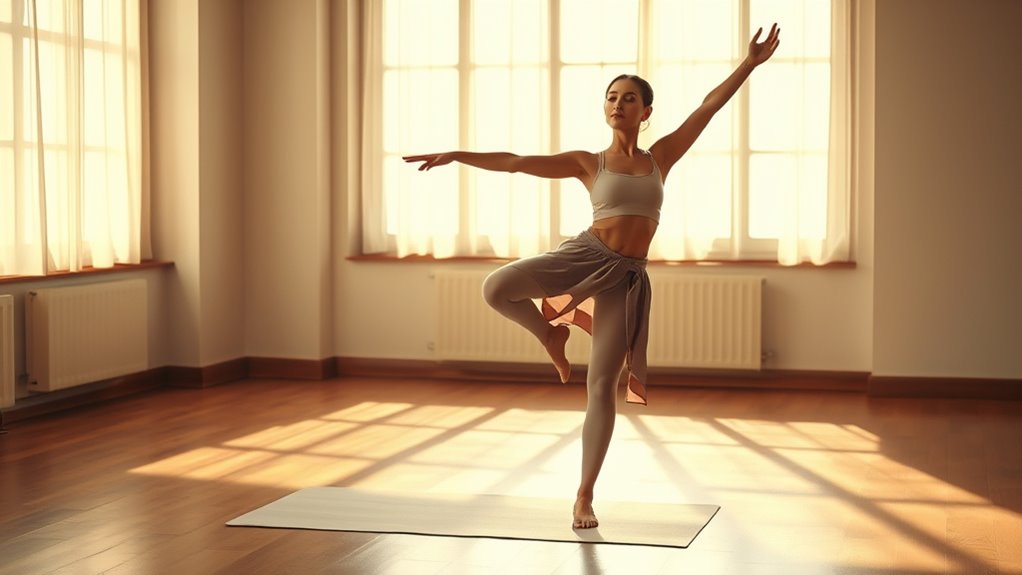
When you practice mindfulness as a dancer, you can significantly enhance your physical awareness, creating a deeper connection between your mind and body.
Mindfulness helps you tune into your bodily sensations, allowing you to recognize your physical limits and prevent injuries. Regular body scans heighten your awareness, guiding you to notice signs of strain or fatigue early.
By focusing on your breath, you improve your coordination and balance, essential for executing movements with precision. This heightened awareness also enables you to maintain proper alignment and posture, enhancing your overall performance.
Ultimately, integrating mindfulness into your dance routine cultivates a more profound understanding of your physical capabilities, allowing you to express yourself more effectively through movement. Additionally, incorporating essential oils for physical awareness can further enhance your practice by promoting relaxation and reducing tension in your body.
Improving Mental Capabilities for Dance Performance
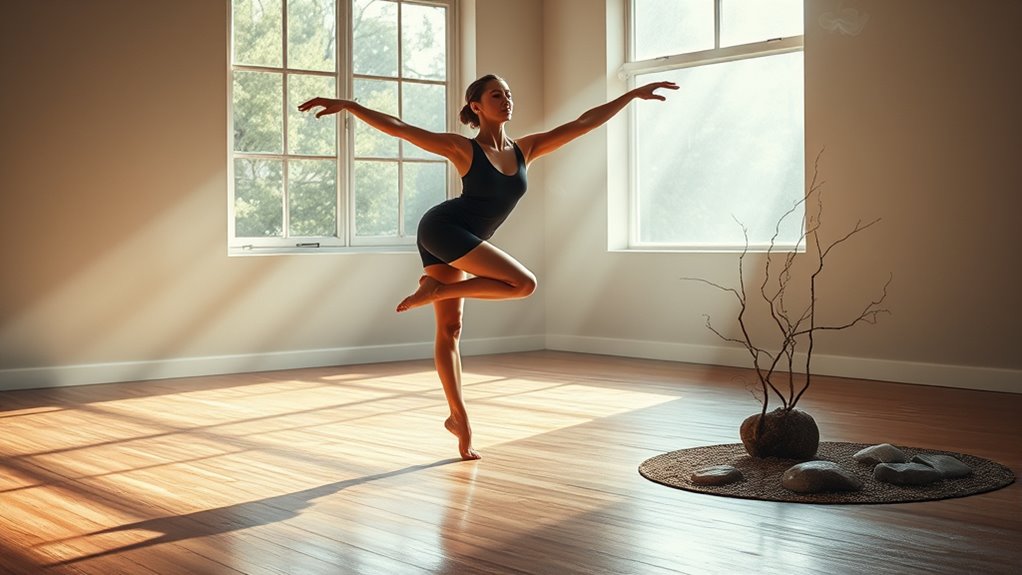
As you immerse yourself in mindfulness practices, you’ll find that your mental capabilities for dance performance improve significantly.
Regular mindfulness enhances your focus and concentration, helping you stay present during performances. By reducing distractions, you engage fully in each moment, facilitating a flow state where self-consciousness fades away.
Simple breathing exercises can sharpen your focus and ease stress, especially during intense sessions. Additionally, mindfulness builds emotional resilience, allowing you to cope with pressure and manage performance anxiety.
You’ll develop mental toughness, adapting swiftly to mistakes and maintaining your confidence. Ultimately, mindfulness not only enhances your retention of steps but also elevates your overall performance, enabling you to shine on stage.
The Role of Mindfulness in Improvisation
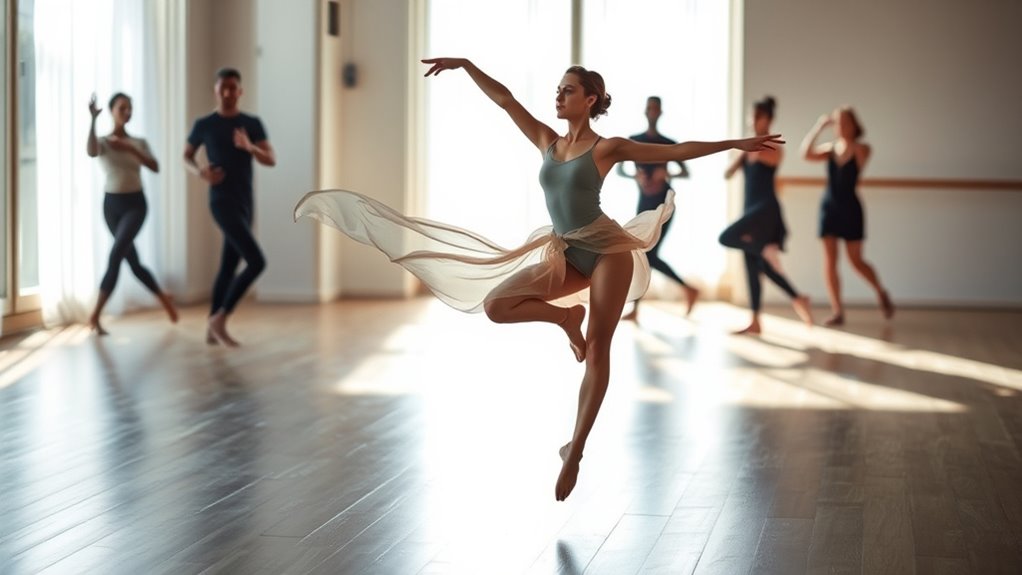
Mindfulness plays a pivotal role in the art of improvisation, allowing dancers to tap into their spontaneous creativity. By cultivating a strong mind-body connection, you can transform spontaneous thoughts into physical movements.
Being present enhances your awareness, helping you focus on the sensations in your body and the environment around you. This non-judgmental observation encourages you to break free from self-censorship, unleashing your subconscious creativity.
Being present sharpens your awareness, allowing you to embrace sensations and break free from self-censorship to unlock your creative potential.
As you embrace mindfulness, you might find yourself entering a flow state, fully absorbed in the moment, which significantly enhances your improvisational skills.
Moreover, connecting deeply with your emotions enables richer expression during your dance, making each performance uniquely yours and allowing you to respond intuitively to whatever unfolds.
Managing Performance Anxiety With Mindfulness Techniques
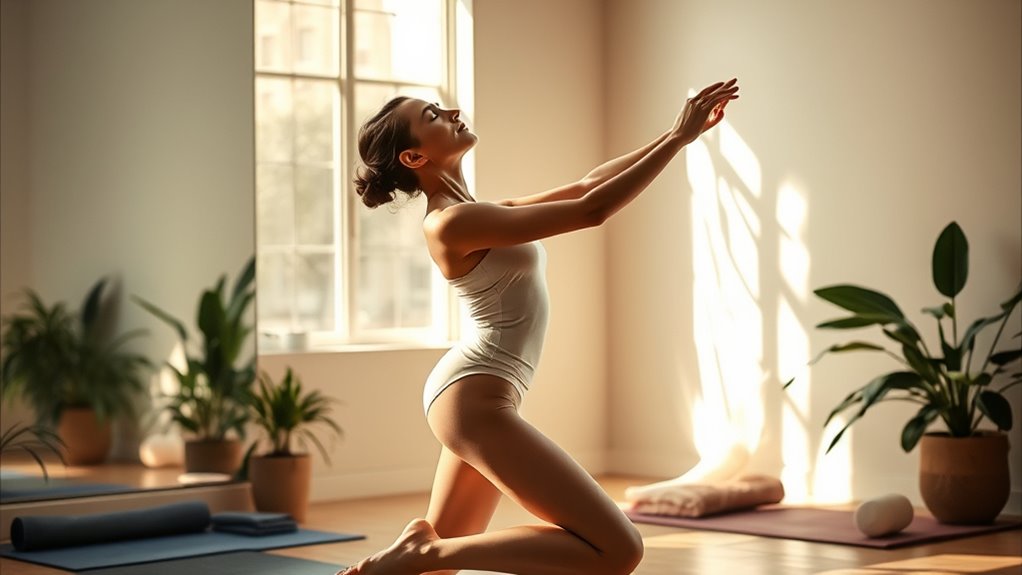
Although performance anxiety is a common challenge for dancers, mindfulness techniques can effectively help you manage it.
Start by incorporating controlled breathing exercises, like the 6-5-6 method, to calm your nervous system before performances. Focus on positive affirmations to counter negative thoughts and build confidence. Establish a pre-performance routine to create a sense of control, reducing anxiety.
Practicing self-compassion allows you to accept yourself without judgment, easing performance pressure. Engaging with supportive communities also provides valuable encouragement.
Exploring Somatic Practices for Holistic Wellness in Dance
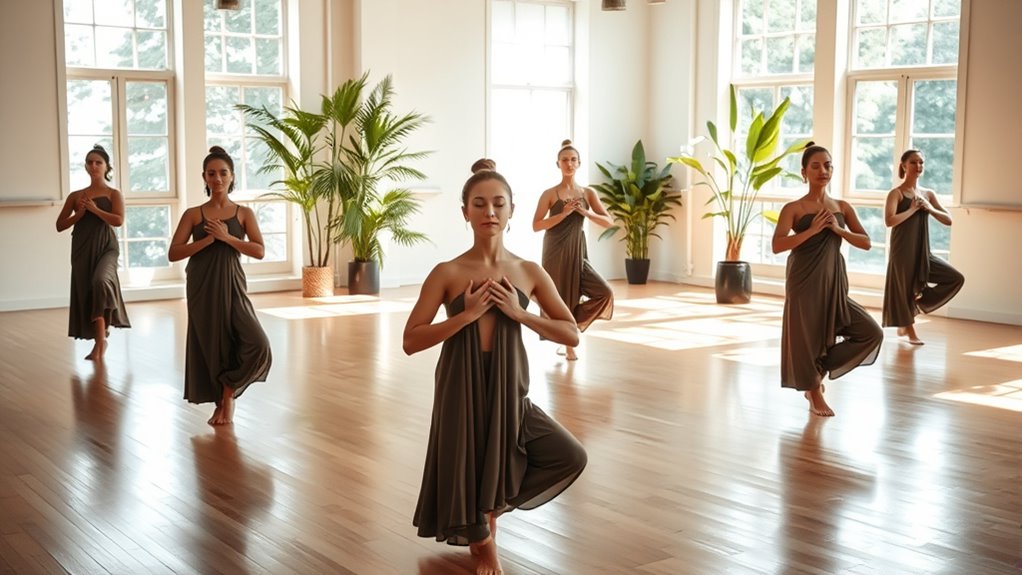
Exploring somatic practices can profoundly enhance your dance experience by fostering a deeper mind-body connection.
These techniques, such as body scans and conscious breathing, boost your physical awareness and improve technique while supporting mental well-being.
Integrating somatics with dance cultivates sensory awareness, allowing you to connect with your body on a new level.
Integrating somatic practices in dance deepens your sensory awareness, fostering a profound connection with your body.
This holistic approach not only enhances your performance but also reduces stress and promotes relaxation.
By practicing mindfulness within somatic frameworks, you’ll find greater clarity and emotional growth, leading to more expressive dancing.
Incorporating methods like the Feldenkrais Method or intuitive dance can further refine your skills, helping you achieve better alignment and flexibility while nurturing a positive body image.
Frequently Asked Questions
How Can Mindfulness Techniques Be Incorporated Into Daily Dance Training?
To incorporate mindfulness techniques into your daily dance training, start by integrating short exercises like mindful breathing or body scans before practice.
During warm-ups, focus on your movements and sensations, letting go of distractions.
You can also use mindful eating during meals to enhance your awareness.
Lastly, establish a distraction-free space for practice, allowing yourself to fully engage with each moment.
These simple steps can significantly enhance your focus and performance.
What Are the Long-Term Benefits of Mindfulness for Dancers?
You might wonder what lasting changes could come from a simple practice. Embracing mindfulness can transform not just your dance, but also your life.
Over time, you’ll notice improved physical awareness, enhanced mental focus, and better emotional regulation. These benefits lead to reduced anxiety and greater self-esteem, allowing you to perform with confidence.
As you cultivate this practice, creativity and resilience flourish, enriching your journey both on and off the stage.
Can Mindfulness Improve Dance Creativity Outside of Structured Practice?
Yes, mindfulness can definitely improve your dance creativity outside of structured practice.
When you engage in spontaneous movement and focus on the present moment, you unlock new expressions and ideas. Practicing mindfulness daily helps you maintain a creative mindset, encouraging exploration and playfulness.
How Do I Start a Mindfulness Practice as a Beginner Dancer?
Starting a mindfulness practice can feel daunting, but it’s simpler than you think.
Begin with just a minute of focused breathing each day. You’ll find that this small step builds your concentration over time.
Incorporate moments of gratitude into your daily routine, reflecting on positive experiences.
As you progress, explore body awareness and mindful movement, letting your senses guide you.
This foundation will enhance your overall awareness and connection to yourself as a dancer.
Are There Specific Mindfulness Exercises for Different Dance Styles?
Yes, there are specific mindfulness exercises tailored for different dance styles.
For ballet, focus on posture awareness and breath control.
In contemporary dance, enhance body awareness and emotional connection.
For group styles like salsa or hip-hop, practice partner awareness and energy flow.
Each exercise helps you stay present, improving performance and expression.
Experiment with these techniques to find what resonates with you, making your dance experience more fulfilling and connected.
Conclusion
So, there you have it! Embracing mindfulness as a dancer isn’t just about floating through the air like a graceful swan; it’s about surviving the chaos of your next performance without hyperventilating. Sure, you could keep stressing over every misstep, or you could channel your inner Zen master and strut your stuff with confidence. After all, who needs a perfect pirouette when you can have the serene aura of a yogi stuck in a leotard?

